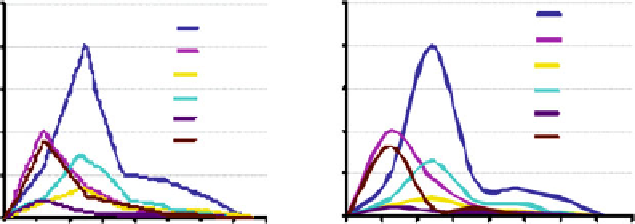Biomedical Engineering Reference
In-Depth Information
Fresh Basil(Sensor Array)
Fresh Basil(GC-MS)
250
250
α
-pinene
α
-pinene
Limonene
200
200
Limonene
Eucalyptol
Eucalyptol
150
150
-pinene
β
β
-pinene
Terpinene
Terpinene
100
100
Estragole
Estragole
50
50
0
0
0 0 0
Time [Hours]
60
80
100 120
140
160
0 0 0
Time [Hours]
60
80
100
120
140
160
Fig. 8 QCM array data and GC-MS measurements comparison of emanated terpenes from fresh
basil
for the comparably better performance of the acrylate-based system here may be the
difference in polarity between water and the sensor material which favored extrac-
tion of the (rather nonpolar) analyte from its polar matrix.
A further—rather complex—real-life matrix points out some other appreciable
aspects of MIP-based chemosensors, namely engine oil degradation sensing. Due to
the sheer volume of production, automotive engine oils play a substantial economic
and ecological role. The point of main interest of course is to find a technique that
actually responds to chemical changes within the matrix rather than more general
parameters, such as polarity or viscosity. MIP coated on QCM for instance can serve
this need [
28
]. In this case the template is a model compound for degraded base oil
components, namely capric acid. For reasons of ruggedness, the polymers in this case
consist of inorganic frameworks—mostly titanate, synthesized by the sol-gel route,
resulting in a reincorporation rate of about 70% of the template and thus appreciable
sensitivity toward degradation. There is one main difference between this strategy and
the sensor arrays introduced previously: while the latter are optimized to selectively
detect a range of analytes in parallel, the former aims at translating a huge amount of
oxidation reactions and their respective products into a single sensor signal.
4.2 Pesticide MIP Sensors as an Example of Environmental
Sensing
Mainly as a consequence of sensitivity restrictions, there are hardly any MIPs
reported that are employed in outdoor environments. One notable exception deals
with an analyte (group) related to the agricultural sector: modern farming widely
applies pesticides in the field, aiming to both comply with food regulations and
achieve optimal yield and quality of crops. However, this has made them a major
source of contamination of water, soil, and as trace contaminants in leafy

Search WWH ::

Custom Search